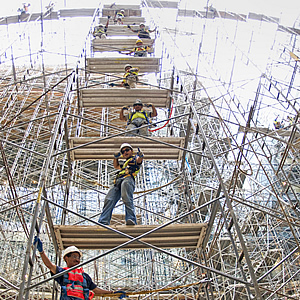Apple, Inc. has done a(nother) clever thing. In the midst of helping its customers succeed in individual goals through its iPhone and iOS systems, the company has also built resources to help groups and individuals succeed in working with each other. The App Store and iTunes are the most obvious examples. But the company has doubled down on the approach more recently. Apple isn’t just a product or software company, it’s a platform company, which is worth the attention of arts and culture managers.
 A ‘platform organization’ (also called an ‘open business’ or a ‘networked enterprise’) “uses its resources to bring people together to achieve a shared purpose” (according to David Cushman in The 10 Principles of Open Business). Such organizations may well make goods or provide services, but they also direct their attention and spend their money helping other people succeed — other businesses, other social organizations, other collectives, other individuals.
A ‘platform organization’ (also called an ‘open business’ or a ‘networked enterprise’) “uses its resources to bring people together to achieve a shared purpose” (according to David Cushman in The 10 Principles of Open Business). Such organizations may well make goods or provide services, but they also direct their attention and spend their money helping other people succeed — other businesses, other social organizations, other collectives, other individuals.
Case in point is Apple’s HealthKit bundle of services and software to help app developers connect their products to the iPhone’s internal sensors and systems. The resources enable developers and their potential customers to work more seamlessly and collectively — Apple isn’t the mediator, but the host and concierge (and maybe even the plumber).
Apple’s latest cases in point are ResearchKit and CareKit (promo video below), which help medical researchers and doctors connect to potential research participants and patients in powerful, collective ways. Millions of people now carry complex, connected, personal information devices with motion sensors and global positioning. Apple is helping groups and individuals use that platform to work with each other. Now, instead of a thousand participants in a research study, there can be millions. Instead of geographically constrained data gathering, it can be global. And instead of being recipients of care, patients can be partners in their care.
What could this mean for the arts and for arts organizations? Sarah Lutman wrote a great reflection on that question back in 2013. And there are certainly many examples of arts organizations spending time and energy facilitating community success. But I’ve been increasingly curious about why it’s not happening more (in ways I can see, at least).
The problem, I think, is scale and capacity. Platform organizations need significant infrastructure to serve, host, and connect a diverse range of constituents. They also need capacity — above and beyond their work on products and services — to make space and provide support. The huge cultural organizations could do this work, and many already do parts of it (multi-venue performing arts centers, major museums, big league cultural producers, presenters, or media organizations). As a sidenote, many/most of those are struggling to be relevant and resonant these days, so perhaps this provides a path.
Another problem is ‘systems’ defined broadly. The software and processes so many organizations have developed are designed for the convenience of the staff, not for the outside world. Rental and reservation systems for example. Beyond that, the business processes we’ve developed have also been designed (quite reasonably) around the metaphors and management needs of internal users. They don’t work well for, or even make sense to, users outside the enterprise.
Which leads me to wonder whether the real ‘platform’ opportunities aren’t individual institutions (except for the large-scale, resource-ready ones), rather they’re collectives. The entire collection of arts organizations in a community or around a discipline could be a platform, if considered and coordinated as such. Each organization would be a node, not a platform. But relentlessly networked to other nodes.
That creates greater scale, and greater opportunity for capacity. Leadership gets tricky in this networked world. Apple has control and coordination of its iPhones, because it designs and builds them all, and builds the software within them. Cultural organizations are subject to separate design and control, making it a true challenge to coordinate, and to focus on the larger public as a whole.
I’m coming to believe that ‘platform organizations’ in the arts will be few and probably far between. But ‘platform collectives’ may well be on the horizon. Fingers crossed.


Thanks so much, Andrew. There are innumerable conversations going on right now in Canada (and beyond) about platforms and “Shared Platforms”. A list of resources (from a consulting project of mine) is available here: http://meansofproduction.to/resources/